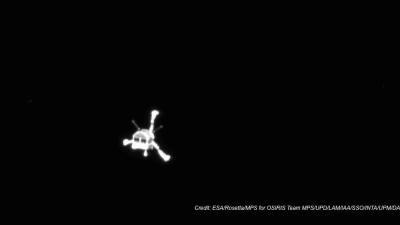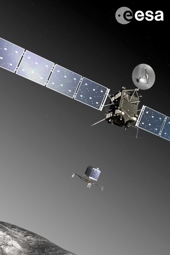LIVE: The End Of The Ultimate Road Trip - ESA Lander Now On Comet's Surface
 The Philae probe is closing in on a historic touchdown on a comet after snapping a farewell picture of the mother ship and a tweet reading: “Hey @ESA_Rosetta, did you get my first postcard?” |
From Wikipedia
 |
Rosetta was launched on 2 March 2004 on an Ariane 5 rocket and reached the comet on 6 August 2014,[7] becoming the first spacecraft to orbit a comet.[8][9][10] (Previous missions had conducted successful flybys of seven other comets.[11]) It is part of the ESA Horizon 2000 cornerstone missions.[12] The spacecraft consists of two main elements: the Rosetta space probe orbiter, which features 12 instruments, and the Philae robotic lander, with an additional nine instruments.[13] The Rosetta mission will orbit 67P/C-G for 17 months and is designed to complete the most detailed study of a comet ever attempted. The mission is controlled from the European Space Operations Centre (ESOC), in Darmstadt, Germany.[14]
The probe is named after the Rosetta Stone, a stele of Egyptian origin featuring a decree in three scripts. The lander is named after the Nile island Philae, where an obelisk was discovered with Greek and Egyptian inscriptions. A comparison of the hieroglyphs on the Rosetta Stone and the obelisk catalysed the deciphering of the Egyptian writing system. Similarly, it is hoped that these spacecraft will result in better understanding of comets and the early Solar System.[15][16] In a more direct analogy to its namesake, the Rosetta spacecraft also carries a micro-etched nickel alloy Rosetta disc donated by the Long Now Foundation inscribed with 13,000 pages of text in 1200 different languages.[17]
The spacecraft has already performed two asteroid flyby missions on its way to the comet.[18] In 2007, Rosetta also performed a Mars swing-by (flyby), and returned images.[19] The craft completed its fly-by of asteroid 2867 Šteins in September 2008 and of 21 Lutetia in July 2010.[20] On 20 January 2014, Rosetta was taken out of a 31-month hibernation mode and continued towards the comet.[21][22] It has been estimated that in the decade preceding 2014, some 2,000 people had assisted in the mission in some capacity.[23]


